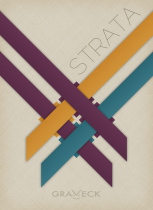
Strata Review
Every once in a while, you’ll fall upon a title that will surprise you. I rarely have this surprise but, for me, Strata has been one of them. Masked as a simple puzzle game, I found myself losing hours to this title in the strive for perfection.
The concept is simple. You are given a square grid of 3x3, 4x4 etc. with coloured tiles on. At the end of each row is a box and clicking on the box will draw a line through that row or column. Below these boxes are a selection of colours to choose from. The objective is to make it so that where two lines intersect, the top most line is the colour of the square it covers.
The beauty of Strata is its simplicity, but the striving force is its challenge. Whilst it seems relatively easy to cross some coloured lines and make the colours match, you will quickly find that it takes a lot of forethought and planning to achieve this result consistently and without undoing your lines. You see, whilst you can undo your lines, doing so will mean you cannot achieve a “perfect” score. When there are only three states: fail, pass and perfect, you will often strive for perfection rather than just passing.

A lot of the game’s appeal, I believe, comes from it’s design. From launching the game, you are presented with only one choice which is to click on an empty box. There’s no “play” button, no “options” or “exit”, just a slightly pulsating box. Instinctively, you will click this box and thus, you have learned how the game works. After clicking the box, a coloured line extends from your cursor off the screen, taking the camera with it. Whether you had realised it or not at this point, you have now been taught the fundamental mechanic of the game and, whilst there is a short tutorial section to explain the need of the colours, you’re already halfway to playing the game.
I believe also that a lot of the games’ appeal is in its subtle accomplishment. There’s no win screen, congratulations, nor fan-fair. When you complete a level, you are presented with a button showing you the next puzzle, not only enticing you through to said level, but also showing you the entirety of the following puzzle. The only praise given is when you complete the level without undoing your lines. By doing this, you will receive a “perfect” above the button.
You can, should you so wish, restart the level at any time, meaning that if you’ve undone some of your lines, you can still perfect it, which I felt was a slightly simplistic, but also means you can 100% the game by going back and redoing some of the earlier puzzles you messed up on. Along with this, there is a hint button which will, you guessed it, give you a hint on how to complete the puzzle. This is important within a game such as this because to continue on in the game, you must first complete the level you’re on. If you were stuck, you could simply give up and turn off the game, but instead, you’re given a hint and maybe you’ll perfect the next one.

The music and graphics have a lot to add to Strata. The look and feel of the game is fantastic and makes me think of papercraft more than anything. It reminds me of childrens books with bits of ribbon stuck to the pages. Along with this, the music is a beautifully played piano that only reacts to your clicks. This means that there’s no repetitive theme tune playing as you think.
Overall, Strata is a fantastically simple game with enough of a challenge to keep even the most well versed in the puzzle genre. You may be surprised at how easily you get hooked! It is a elegantly designed title with a lot more to offer than first meets the eye.
Strata (Reviewed on Windows)
Excellent. Look out for this one.
Strata is a fantastically simple game with enough of a challenge to keep even the most well versed in the puzzle genre. You may be surprised at how easily you get hooked! It is a elegantly designed title with a lot more to offer than first meets the eye.









COMMENTS